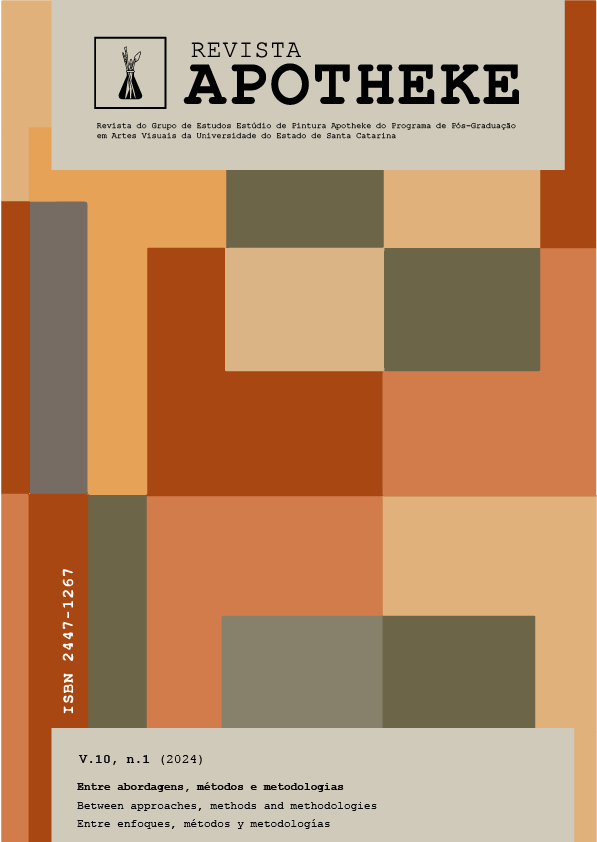Between Art/Education and life: reconstructing forgotten memories
DOI:
https://doi.org/10.5965/244712671012024091Keywords:
memory, art/education, visual arts, contemporary artAbstract
The present article presents processes from the project “What is your forgotten memory?”, which aims to stimulate the individual’s artistic practice based on his experiences, which are surrounded by forgotten memories, but that are remembered through visual objects kept by family members. Sending letters to different recipients was the method adopted so that art could circulate outside the studio, reaching individuals who often have no direct contact with Visual Arts. In this experiment, we use memory concepts from Bosi (2006) and Chaui (2009) to send a letter to the recipients who participated in the project. From the letters sent, which instigate the search for a forgotten memory and consequently the artistic production of the recipients, we sought to develop the self-expression of individuals, proposing an answer to the question “what is your forgotten memory?” In this sense, I interpret the power of this research reverted in the experiences carried out in creative processes and products created, developing in a collective way the concept of memory and tangenting possibilities of Contemporary Art in my formation as a teacher/artist/researcher.
Downloads
References
BOSI, Ecléa. Memória e sociedade: Lembrança dos velhos. 13ª edição. São Paulo: Companhia das Letras, 2006.
CHAUI, Marilena. Convite à filosofia.13ª edição. São Paulo: Editora Ática, 2009.
LOWENFELD, Viktor; BRITTAIN, W. Lambert. Desenvolvimento da capacidade criadora. Tradução Álvaro Cabral. São Paulo: Editora Mestre Jou, 1977.
SALLES, Cecilia Almeida. Gesto inacabado: processo de criação artística. 5ª edição revista e ampliada. / Cecilia Almeida Salles. Apresentação de Elida Tessler. - São Paulo: Intermeios, 2011.
SALLES, Cecilia Almeira. Redes de criação: construção da obra de arte. 2ª edição. São Paulo: Editora Horizonte, 2006.
VASCONCELOS, Flávia Pedrosa. Designare: pontes artístico/educativas na formação docente em Artes Visuais. Lisboa: Chiado, 2015.
Downloads
Published
How to Cite
Issue
Section
License
Copyright (c) 2024 Ana Julia Dotto Guaragni, Flávia Maria de Brito Pedrosa Vasconcelos

This work is licensed under a Creative Commons Attribution-NonCommercial 4.0 International License.
Copyright and Licensing Policy
Authors of works submitted to Revista APOTHEKE authorize their publication in both print and digital formats exclusively for academic purposes. Reproduction is permitted, provided that the source is properly cited. Authors confirm the originality, authorship, and unpublished status of their manuscripts.
Articles published by the journal are freely available and intended for academic and non-commercial use only. All copyrights are transferred to the journal. The content of signed articles reflects the views of their respective authors and not the official position of Revista Apotheke. The author(s) agree to always cite the following reference when republishing or referring to the content originally published in Revista Apotheke:
“This article was originally published by Revista Apotheke in volume (insert volume), number (insert number), year (insert year), and is available at: http://www.revistas.udesc.br/index.php/APOTHEKE/index”
It is the sole responsibility of the authors to obtain written permission for the use of any material protected by copyright law included in their articles. Revista Apotheke is not responsible for copyright infringements committed by contributors.
Authors retain copyright and grant the journal the right of first publication, with the work licensed under a Creative Commons Attribution-NonCommercial License (CC BY-NC):
-
Attribution (BY): Licensees are allowed to copy, distribute, display, perform, and create derivative works, provided that proper credit is given to the author or licensor, in the manner specified.
-
NonCommercial (NC): Licensees may use the material only for non-commercial purposes.
After publication, authors retain the rights to their work and may republish the text.



